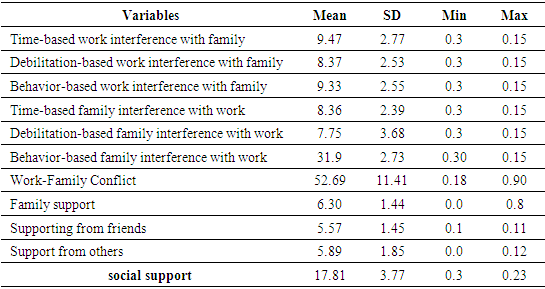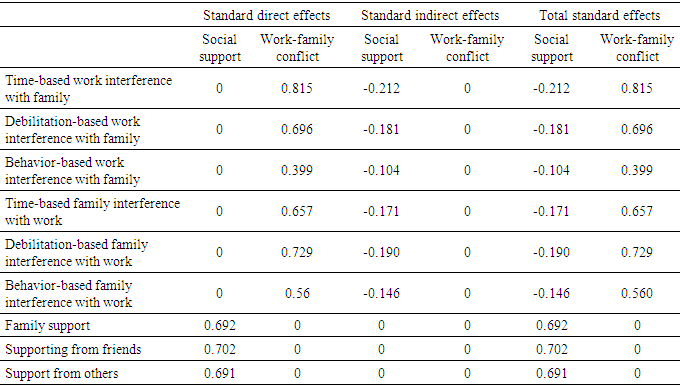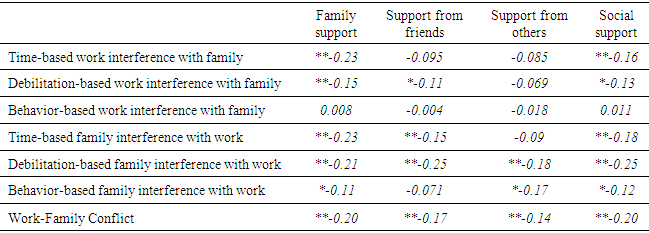-
Paper Information
- Next Paper
- Paper Submission
-
Journal Information
- About This Journal
- Editorial Board
- Current Issue
- Archive
- Author Guidelines
- Contact Us
International Journal of Psychology and Behavioral Sciences
p-ISSN: 2163-1948 e-ISSN: 2163-1956
2017; 7(3): 79-82
doi:10.5923/j.ijpbs.20170703.03

The Relationship between Perceived Social Support Dimensions and Work-Family Conflict among Employees in Kish Free Zone Organization
Sahar Monfared1, Sheyda Soudagar2, Maryam Bahrami Hidaji2
1Department of Psychology, Kish International Branch, Islamic Azad University, Kish Island, Iran
2Department of Psychology, Karaj Branch, Islamic Azad University, Karaj, Iran
Correspondence to: Sahar Monfared, Department of Psychology, Kish International Branch, Islamic Azad University, Kish Island, Iran.
| Email: |  |
Copyright © 2017 Scientific & Academic Publishing. All Rights Reserved.
This work is licensed under the Creative Commons Attribution International License (CC BY).
http://creativecommons.org/licenses/by/4.0/

The aim of this study was to investigate the relationship between perceived social support subscales and work-family conflict dimension among employees working in Kish Free Zone Organization. To this end, a descriptive-correlational research method was employed. The research population included all employees working Kish Free Zone Organization, of whom 378 were selected as the respondents through purposeful sampling (taking interviews before sampling). The instruments used to collect data were Work-Family Conflict Questionnaire (Carlson et al., 2000) and Perceived Social Support Questionnaire (Wax et al., 1986). The collected data were analyzed through Pearson's correlation coefficient, path coefficient, regression coefficient and the critical ratio test (t) using SPSS (Version 20). The results showed that with increasing social support, work-family conflict can reduce significantly.
Keywords: Work-family conflict, Perceived social support, Employee
Cite this paper: Sahar Monfared, Sheyda Soudagar, Maryam Bahrami Hidaji, The Relationship between Perceived Social Support Dimensions and Work-Family Conflict among Employees in Kish Free Zone Organization, International Journal of Psychology and Behavioral Sciences, Vol. 7 No. 3, 2017, pp. 79-82. doi: 10.5923/j.ijpbs.20170703.03.
Article Outline
1. Introduction
- Work is considered as a very valuable factor in terms of individuals’ health. However, some aspects of individuals’ working responsibilities can be potentially stressful for them, one of the most important of them being role ambiguity (Golparvar, Vaseghi, & Javadian, 2011). Role ambiguity can in fact lead to decreased concentration thus reducing people’s decision-making power (Askari & Nakel Zadeh, 2010). During the 1980s, with increased participation of women in the world of work, the so-called work-family conflict first appeared. The encounter between women’s working roles with other family roles results in role conflict among them because women’s functioning in working roles does not make their other roles less prominent, but they must also be willing to do other things (Safiri & Zare, 2006). Kahn et al., (1964) have provided an acceptable definition of work-family conflict. They define work-family conflict as "an inter-role conflict, where the pressures from job and family roles are incompatible with each other in some respects. They classified the work-family conflict in three categories: a) time-based conflict which happens when the time spent for activities within a role cannot generally be sacrificed for activities within another role, 2) pressure-based conflicts which occurs when psychological demands in a given role interfere with demands in other roles, and c) behavior-based conflict which occurs when certain patterns of behavior within a role are incompatible with expected behaviors in another role. Mazerolle, Bruening, and Casa (2008) also believe that work-family conflict is created because of the inconsistency between work demands and family demands. According the authors, this phenomenon occurs when the expectations, demands, and time constraints related to an individual's personal and professional life are not compatible. In this case, it is difficult to manage these two conflicting responsibility. As it was stated in the introduction part, work-family conflict can have a direct relationship with the socialization process. A study conducted by Mitchell et al., (2010; as cited in Sabeti et al., 2012) on the relationship between work and family social support, sources of stress, and work-family conflict showed that social support and controlling job involvement are the most important precedents of sources of role conflict and work-family conflict. However, perceived social support is a multidimensional concept that has been defined in various ways. For example, it can be regarded as a resource provided by others, as the means for coping with stress, or as an exchange of resources (Schultz and Schwarzer, 2004) Some researchers have defined social support as love, companionship, care, respect, attention, and support received by an individual from other individuals or groups such as family members, friends, and significant others (Sarafino, 1998). Some see social support as a social reality and others see it a product of an individual’s perception. Sarson (1988) considers social support as a multi-dimensional than can be both real and imaginary (Alipur, 2006). Work-family conflict can be generally said to be important for individuals and organizations because it is the source of anxiety and bring about consequences such as loss of performance in doing parenting tasks, moodiness, decreased productivity for organizations, reduced sense of responsibility, increased delay, and absenteeism among employees. Individuals’ lifestyle is effective on how to deal with this conflict. Therefore, given many negative consequences associated with work-family conflict, it has been the focus of several studies. Accordingly, the present study aims to investigate the relationship between perceived social support subscales and work-family conflict dimension among employees working in Kish Free Zone Organization.
2. Method
- A descriptive-correlational research method was employed to conduct this study. The research population included all employees working Kish Free Zone Organization, with a total number of 840 persons in the second half of 2015, of whom 393 employees were selected as the respondents through purposeful sampling (taking interviews before sampling). It should be noted 15 persons were excluded from the study as they did not complete the questionnaire administered to them. Therefore, the final sample included 378 respondents. The inclusion criteria was having a job experience of at least 2 years in Kish Free Zone Organization, having finished at least elementary school education, being married (marriage duration up to 20 years) and exit criteria consists of being single, having a job experience of less than 2 years, and having no history of psychiatric or psychological interventions during the last year. The collected data were analyzed through descriptive and inferential statistics including Pearson's correlation coefficient, path coefficient, regression coefficient and the critical ratio test (t) using SPSS (Version 20).
3. Instruments
- Two instruments were used in this study to collect data:Work-Family Conflict Scale This scale was developed by Carlson et al., (2000) to measure 6 subscale of work-family conflict using 18 items. Perceived Social Support Questionnaire This questionnaire which was developed by Wax, Philips, Holly, Thompson, Williams, and Stewart in 1986 contains 23 items. Ebrahimi Qavam (1992) changed the questionnaire scoring into a scale of zero and one in order to calculate Cronbach's alpha for the items in the questionnaire (Hemati Rad and Sepahmansour, 2008; cited in Khabbaz et al., 2011).
4. Research Findings
- Table 1 shows the mean and standard deviation for the variables under analysis:
|
|
|
5. Discussion and Conclusions
- As it was stated earlier, the aim of this study was to investigate the relationship between perceived social support subscales with dimensions of work-family conflict among employees working Kish Free Zone Organization. As the results of the study indicated, the indirect effect of work-family conflict with the impact of variable social support is equal to -0.056 and as t-value calculated for this effect is greater than 1.96, the null hypothesis is rejected at confidence level of 0.95. Accordingly, it can be concluded that as social support increases the mediating effect of work-family reduces significantly. This finding is consistent with the results of a study conducted by Fatehizadeh et al., (2007) who explored the relationship between social support and work-family conflict among working women. Borquez and Benjamin (2011) studied role of private industries in work –family conflict and its implications for the well-being of young mothers. Hess and Anthony (2010) examined work-family conflict in the East compared to the West to understand the conflict in both directions from work to family and family to work in the Eastern culture as well as to determine the relationship between work-family conflict and family work, job satisfaction, family, community, and life. Hassani, Aghaei, and Rezaei Jamaluei (2013) explored the relationship of five-factor model of personality and negative affect relationships with family conflict among female teachers. In addition, Masoudnia (2011) studied the relationship between perceived social support and postpartum depression. Hossam et al., (2011) investigated the association between perceived social support, mental health and life satisfaction among Shahed students in state universities in Gorgan. Social support as a very important source in both work and family life can reduce the negative effects of job and family stressors. Generous, Parasuraman, and Greenhaus (1992) argue that social support as an adjustment source can play a significant role in the face of job and family stressors. First, social support can directly affect pressure and other negative consequences of these stressors in different spheres of life and reduce pressure level experienced. Also, social support can moderate the effects of stressors on individuals’ health profiles and welfare in both family and career life. A review of studies on the relationship between social support and work-family conflict shows that the lack of social support in both work and family life leads to higher levels of work-family conflict (Matthews, Bulger, & Barnes & Farrell, 2010; Cortes, Colombo, & Gilsiri, 2010, Blanch & Aluja, 2012; Seeger & Weiss, 2009). In explaining the components of the two variables under study, it should be noted that if a person receives sufficient support from family, friends, and others (such as peers in the workplace), he can effectively manage time-based work interference with family, debilitation-based work interference with family, behavior-based work interference with family, time-based family interference with work, debilitation-based family interference with work, and behavior-based family interference with work. Given that the population in this study was limited to employees in Kish Free Zone Organization, it is suggested that this study is replicated in other communities especially among employees in free zones in other cities and cultures to make it possible to compare the results. In addition, future research can explore the role of other influential variables such as education level, age, marital status, number of children, and household economic position among employees.
 Abstract
Abstract Reference
Reference Full-Text PDF
Full-Text PDF Full-text HTML
Full-text HTML

